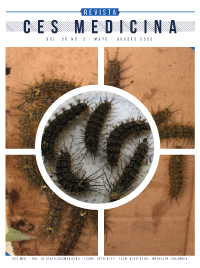The Fragility Index and its characteristics in randomized clinical trials of diabetes mellitus
DOI:
https://doi.org/10.21615/cesmedicina.6632Keywords:
fragility index, diabetes mellitus, controlled clinical trialsAbstract
Introduction: to evaluate the robustness of the results, a tool called the Fragility Index (FI) has been proposed, which is defined as the minimum number of patients that have to be changed from "No events" to "Events" in the intervention group to change a statistically significant to nonsignificant result. Showing that among a lower Fragility Index, the results of the trial will be less robust or more fragile. Different authors have found that the significance of the results of many controlled clinical trials (RCTs) depend on very few events. The objective of the study is to evaluate the FI of controlled clinical trials in diabetes mellitus in five of the general medical journals with the greatest impact factor worldwide. Methods: an electronic search was conducted in PubMed to identify randomized clinical trials in The Annals of Internal Medicine, BMJ, The Lancet, The New England Journal of Medicine and JAMA. Clinical trials were reviewed with diabetic or prediabetic patients and the FI was then calculated for each outcome according to the method described by Walsh et al, using 2x2 contingency tables. A priori was planned to use the Spearman correlation coefficient to evaluate the direct correlation between the Fragility Index and sample size, number of events, p-value and follow-up time. The significance of all the results was evaluated with a value of p <0.05. Results: the median Fragility Index was 11, and in three studies (7.3%) the result were not statistically significant after recalculating the p value with Fisher's exact test. A slight direct relationship between the number of events and the Fragility Index (Rho = 0.343, p = 0.02) was found and a moderate inverse correlation was observed between the p value and the FI (Rho = -0.632, p = 0.000 ). No statistically significant correlation was found between sample size, follow-up time and losses with the FI. Conclusions: in controlled clinical trials on diabetes, we found that the statistically significant results depend on a few events, evidenced by a low value in the Fragility Index. The values of this measurement are related to the number of events and negatively to the p value.
Downloads
References
Walsh M, Srinathan SK, Mcauley DF, Mrkobrada M, Levine O, Ribic C, et al. The statistical significance of randomized controlled trial results is frequently fragile : a case for a Fragility Index. J Clin Epidemiol. 2014;67(6):622-8.
Bennett DA. How to Distinguish between Statistically Significant Results and Clinically Relevant Results. Front Neurol Neurosci. 2016;39:37-49.
Ridgeon EE, Young PJ, Bellomo R, Mucchetti M, Lembo R, Landoni G. The Fragility Index in Multicenter Randomized Controlled Critical Care Trials*. Crit Care Med J. 2016;44(7):1278-84.
Sterne JAC, Smith GD. Sifting the evidence — what ’ s wrong with significance tests ? Br Med J. 2001;322(January):226-30.
Carter RE, Mckie PM, Storlie CB. The Fragility Index : a P -value in sheep ’ s clothing ? Eur Heart J. 2016;1-3.
Walter SD. STATISTICAL SIGNIFICANCE AND FRAGILITY CRITERIA FOR ASSESSING A DIFFERENCE OF TWO PROPORTIONS. J Clin Epidemiol. 1991;44(12):1373-8.
Evaniew N, Files C, Smith C, Bhandari M, Ghert M, Walsh M, et al. The fragility of statistically significant findings from randomized trials in spine surgery : a systematic survey. Spine J. 2015;15(10):2188-97.
Trimmel H, Landsteiner K, Hospital G, Voelckel WG, Ahmed W, Health S, et al. Does Sample Size Matter When Interpreting the Fragility Index? Crit Care Med J. 2016;44(1):1142-11431. Trimmel H, Landsteiner K, Hospital G,.
Tignanelli CJ, Napolitano LM. The Fragility Index in Randomized Clinical Trials as a Means of Optimizing Patient Care. JAMA Surg. 1 de enero de 2019;154(1):74.
Contribution O. Contradicted and Initially Stronger Effects in Highly Cited Clinical Research. J Am Med Assoc. 2017;294(2):218-28.
Khan M, Evaniew N, Gichuru M, Habib A, Ayeni OR, Bedi A, et al. The Fragility of Statistically Significant Findings From Randomized Trials in Sports Surgery: A Systematic Survey. Am J Sports Med. 2016;1-7.
Del Paggio JC, Tannock IF. The fragility of phase 3 trials supporting FDA-approved anticancer medicines: a retrospective analysis. Lancet Oncol. agosto de 2019;20(8):1065-9.
Caldwell J-ME, Youssefzadeh K, Limpisvasti O. A method for calculating the fragility index of continuous outcomes. J Clin Epidemiol. agosto de 2021;136:20-5.
Goerke K, Parke M, Horn J, Meyer C, Dormire K, White B, et al. Are results from randomized trials in anesthesiology robust or fragile? An analysis using the fragility index. Int J Evid Based Healthc. marzo de 2020;18(1):116-24.
Contrast FORA, Two OF. The unit fragility index : an additional appraisal of “ statistical significance ”. J Clin Epidemiol. 1990;43(2):201-9.
Docherty KF, Campbell RT, Jhund PS, Petrie MC, Mcmurray JJ V. How robust are clinical trials in heart failure ? Eur Heart J. 2016;1-10.
Skinner M, Tritz D, Farahani C, Ross A, Hamilton T, Vassar M. The fragility of statistically significant results in otolaryngology randomized trials. Am J Otolaryngol. enero de 2019;40(1):61-6.
Tzelves L, Chatzikrachtis N, Lazarou L, Mourmouris P, Pinitas A, Tsirkas K, et al. Fragility index of urological literature regarding medical expulsive treatment. World J Urol. octubre de 2021;39(10):3741-6.
Maldonado DR, Go CC, Huang BH, Domb BG. The Fragility Index of Hip Arthroscopy Randomized Controlled Trials: A Systematic Survey. Arthrosc J Arthrosc Relat Surg. junio de 2021;37(6):1983-9.
Vargas M, Marra A, Buonanno P, Coviello A, Iacovazzo C, Servillo G. Fragility Index and Fragility Quotient in Randomized Controlled Trials on Corticosteroids in ARDS Due to COVID-19 and Non-COVID-19 Etiology. J Clin Med. 14 de noviembre de 2021;10(22):5287.
Landis JR, Koch GG. The Measurement of Observer Agreement for Categorical Data Data for Categorical of Observer Agreement The Measurement. Biometrics. 2013;33(1):159-74.
Rosa María Martínez Ortega, Leonel C. Tuya Pendás MMOrtega. El coeficiente de correlacion de los rangos de spearman caracterizacion. Rev Haban Cienc Méd Habana. 2009; VIII(2).
Khan MS, Ochani RK, Shaikh A, Usman MS, Yamani N, Khan SU, et al. Fragility Index in Cardiovascular Randomized Controlled Trials. Circ Cardiovasc Qual Outcomes [Internet]. diciembre de 2019 [citado 9 de febrero de 2022];12(12). Disponible en: https://www.ahajournals.org/doi/10.1161/CIRCOUTCOMES.119.005755
Lin L. Factors that impact fragility index and their visualizations. J Eval Clin Pract. abril de 2021;27(2):356-64.
Desnoyers A, Wilson BE, Nadler MB, Amir E. Fragility index of trials supporting approval of anti-cancer drugs in common solid tumours. Cancer Treat Rev. marzo de 2021; 94: 102167.
Downloads
Published
How to Cite
Issue
Section
License
Copyright (c) 2022 CES Medicina

This work is licensed under a Creative Commons Attribution-NonCommercial-ShareAlike 4.0 International License.
Derechos de reproducción (copyright)
Cada manuscrito se acompañará de una declaración en la que se especifique que los materiales son inéditos, que no han sido publicados anteriormente en formato impreso o electrónico y que no se presentarán a ningún otro medio antes de conocer la decisión de la revista. En todo caso, cualquier publicación anterior, sea en forma impresa o electrónica, deberá darse a conocer a la redacción por escrito.
Plagios, duplicaciones totales o parciales, traduccones del original a otro idioma son de responsabilidad exclusiva de los autores el envío.
Los autores adjuntarán una declaración firmada indicando que, si el manuscrito se acepta para su publicación, los derechos de reproducción son propiedad exclusiva de la Revista CES Medicina.
Se solicita a los autores que proporcionen la información completa acerca de cualquier beca o subvención recibida de una entidad comercial u otro grupo con intereses privados, u otro organismo, para costear parcial o totalmente el trabajo en que se basa el artículo.
Los autores tienen la responsabilidad de obtener los permisos necesarios para reproducir cualquier material protegido por derechos de reproducción. El manuscrito se acompañará de la carta original que otorgue ese permiso y en ella debe especificarse con exactitud el número del cuadro o figura o el texto exacto que se citará y cómo se usará, así como la referencia bibliográfica completa.
| Article metrics | |
|---|---|
| Abstract views | |
| Galley vies | |
| PDF Views | |
| HTML views | |
| Other views | |



